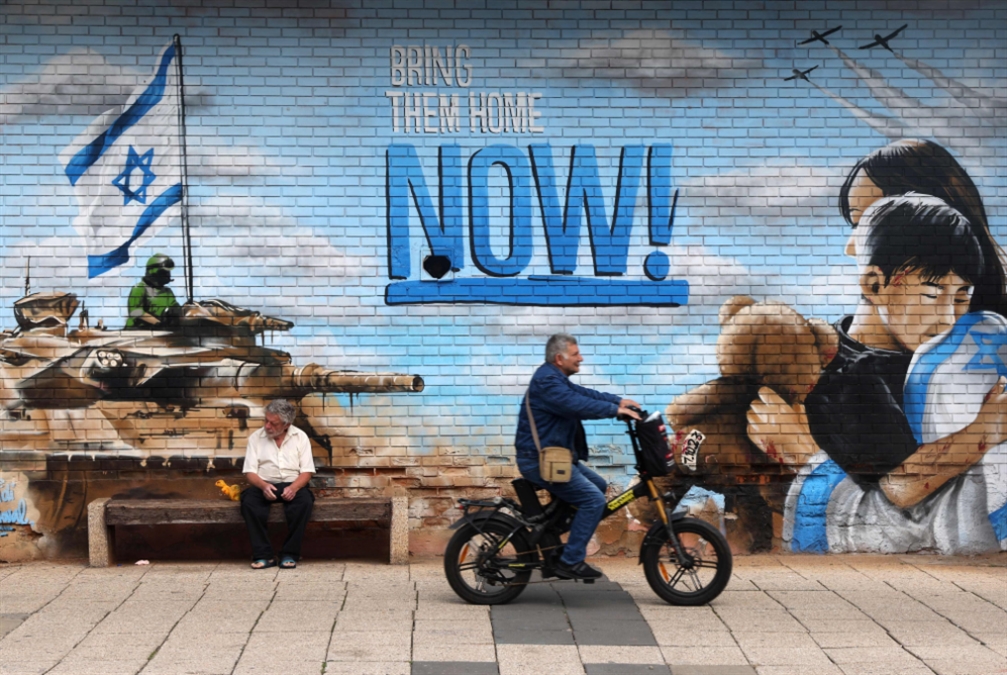
Zionist mural in Occupied Palestine depicts Israeli occupation bombers and a tank and settlers hugging with the phrase "Bring them home NOW!" Nov. 23, 2023. Photo: Associated Press

Orinoco Tribune – News and opinion pieces about Venezuela and beyond
From Venezuela and made by Venezuelan Chavistas

Zionist mural in Occupied Palestine depicts Israeli occupation bombers and a tank and settlers hugging with the phrase "Bring them home NOW!" Nov. 23, 2023. Photo: Associated Press
By Ibrahim al-Amin – Feb 28, 2024
Details of ongoing negotiations between regional and international parties and resistance forces show that these so-called “mediators” are nothing but tools to pressure the resistance in Gaza in this battle of starvation. It is no longer a secret that both the Egyptian and the Qatari sides are not really playing the role of mediators trying to bridge the gap between the conflicting parties. Rather they are trying to satisfy the United States which is backing all the enemy’s demands.
A review of the negotiations that have taken place over the past three weeks shows that Israeli procrastination has been done with US support and Egyptian and Arab collusion. The only objective stated by CIA Director William Burns during the meetings was that the dire situation in Gaza necessitates pressure from the residents of Gaza themselves to push their leaders towards an agreement. One of the participants was quoted as saying, “The US was clear and unequivocal: Gaza should trade prisoners for food.”
While the Qatari side appears outwardly sympathetic to the Palestinian side, trying to humanize its mission, the Egyptian side is behaving with great indifference, stemming from the belief that no party has any power or influence to go against what the United States and Israel want. In practical terms, the US and “Israel” are aware that the Qatari side will not exert the amount of pressure on the Palestinian resistance as desired by Washington. Therefore, the Egyptians were asked to exert the highest level of pressure on the resistance, accusing it of being “irresponsible, both during the days of the Operation Al-Aqsa Flood and in managing the unequal military battle,” and that it, according to them, “ignores the undeniable fact that there is no one in the world today who stands by the Palestinians until their requests are more palatable.”
IMF Vows To Support Egypt as Nation Braces for Mass Displacement of Gazans
According to Al-Akhbar’s sources, Hamas has not yet issued its official and final response, and communications are ongoing between the movement’s leadership abroad and its leadership internally, as well as with the rest of the Palestinian resistance factions. Although there is a prevailing negative atmosphere within the resistance so far, there are “indications” emerging from discussions far from the media that suggest that the Egyptian and Qatari mediators have pledged to the United States that the agreement will be concluded before the beginning of Ramadan.
This indicates that when US President Joe Biden announced yesterday that “we’re close” to an agreement, it is an attempt to compel Israel to conclude the agreement and to compel the Egyptian and Qatari mediators to “force” the resistance to comply with the agreement. As for the ongoing negotiations on the issues, they can be summarized as follows:
• The modified agreement framework paper, approved on February 22 and delivered to Hamas, sidelined the basic paper previously presented on January 28, as well as the idea of a long truce or sustainable calm offered in three stages. It appears that the United States, Egypt, and Qatar have backtracked and agreed to ‘Israel’s’ endeavor to make the truce limited to the first stage only.
• The enemy has completely rejected, with the approval and cover of the three parties, all provisions that the resistance has articulated as necessary to achieve a sustainable cessation of hostilities. ‘Israel’ has also rejected the idea of gradual withdrawal from Gaza during the implementation of the three stages of the ceasefire. The new proposal has granted the occupation forces the right to continue occupying significant territory in northern and southern Gaza and holding onto the entire central area on both sides of the Gaza Valley.
• The three mediators agreed to the enemy’s request that only women, children, and the elderly would be allowed to return to their homes in the northern Gaza Strip under the pretext that the enemy considers the return of men between the ages of 18 and 60 as a revival of Hamas’ civilian and military formations.
• It is apparent that the new ideas in this document are merely rewordings of proposals previously presented by the Egyptians to the head of the Hamas political bureau, Ismail Haniyeh, with the wording adjusted to align with the enemy’s demands. It is clear that the feedback that Haniyeh had provided to the Egyptians previously was not taken into consideration and the Egyptians said there is no possibility of achieving more.
• The Egyptian side exerted pressure not only on Hamas but also on other factions in the Palestinian resistance, reiterating its argument that no one in the world can oppose the United States or Israel. It is attempting to persuade the resistance to accept the agreement based on a principle of “take and demand.”[1]
• During the negotiations, the occupation forces escalated their criminal actions of bulldozing and destruction while tightening control over all crossings between cities and major towns within the Gaza Strip. The enemy also incited local Palestinians under the pretext of humanitarian pressure, exploiting protests previously held by groups of locals due to the blockade and hunger. Efforts were made to mobilize groups affiliated with the Egyptians and the Palestinian Authority to demand that Hamas accept the deal to provide for the necessities of life. Voices also emerged demanding the release of all ‘Israeli’ hostages to lift the blockade.
• The negotiations contributed to revealing Washington’s actual position, which rejects a comprehensive ceasefire and agrees to Israeli demands, including granting the enemy authority to oversee the supposed aid program to be introduced. The Egyptians informed the Palestinian side that an agreement was reached with the US and the occupation forces to expedite the construction of new camps to accommodate hundreds of thousands of displaced persons from the Rafah area during the ceasefire. This was accompanied by the Egyptian-Jordanian-Emirati-French charade which was a scandal for these countries, seeking to appease their people by talking about their role in delivering aid. It was also during the negotiations that the enemy intends to carry out a military operation in Rafah immediately after the end of any agreed upon truce.
[1] Translators Note: This phrase carries the connotation of an approach to negotiation that “takes” what is initially offered before persisting in “demanding” more. It has a similar meaning to the English idiom “take what you can get”.
Translation: Orinoco Tribune
OT/DZ/SC

Ibrahim Al-Amin is a Lebanese journalist, and the editor-in-chief of the Lebanese publication Al Akhbar.